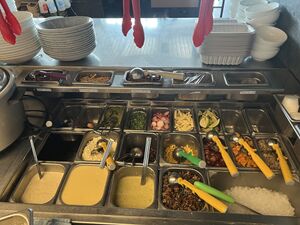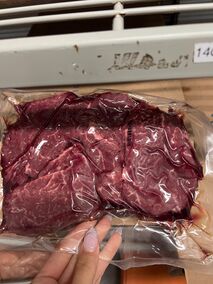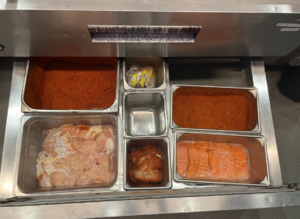Course:FNH200/Projects/2022/Option A - Interview with Earls Restaurant Head Chef
Introduction
For our project we wanted to interview a food professional for a more in-depth look at how food is stored, processed and consumed. We were lucky enough to obtain an interview with Head Chef, Joe Britt, who spoke to us on his experience working at Earls Ambleside Restaurant. Furthermore, our project ties together different aspects of the food industry using both information from Joe, as well as our own knowledge from FNH 200.
Interview Questions
- How are meats, seafood, and vegetables stored in the restaurant? What are some measures taken to ensure these foods are safe for consumption and free from food borne illnesses?
- How are dairy products stored, prepared, and served to minimize the rate of spoil? What is your restaurant’s procedure on how long dairy products can be out of refrigeration for?
- What do food hygiene inspections look for? How often do they come? How do you prepare the kitchen for a hygiene inspection?
- Hypothetically, what would happen if foods weren’t stored properly? How do you defrost (and re-frost) certain foods that need to be utilized within a certain time?
- How has Covid-19 shaped/changed the restaurant's food handling processes?
- How much food waste is produced on a weekly basis? Does the restaurant have any measures to prevent such food waste? (such as composting/recycling etc.)
- What are some safety measures taken when making alcoholic drinks? For example using raw egg whites in certain drinks?
- What does your allergy protocol look like? How do the chefs typically deal with food items that consumers are allergic to in the kitchen?
Summarize and Reflection
How are meats, seafood, and vegetables stored in the restaurant? What are some measures taken to ensure these foods are safe for consumption and free from food borne illnesses?
Food is stored and organized according to the provincial guideline rules depending on its date brought into the store and shelf life. All food is stored at appropriate temperatures, clearly labelled, and grouped together according to categories to prevent potential cross contamination and risk of spoilage as required by BC Ministry of Health (Module 4). For example, all raw protein is stored together while all ready to eat foods (eg sushi grade sashimi) are stored in containers on the other side of the room. The ready to eat food is packaged separately and vacuumed sealed upon delivery to maintain its freshness and quality. Each week, an estimate amount of food the restaurant needs is correctly ordered, prepared, and tasted to ensure that it is safe for consumption. In addition, storage areas like coolers are checked 4 times a day by dairy, protein, and salad chefs to ensure no spoilage occurs throughout the day. There are a few methods used to ensure the quality of fresh seafood and meats. The food undergoes systems of a series of checks from the date it is delivered to consumption. Firstly, the freezers and coolers are constantly checked for accurate temperatures, and specific foods such as meat receive regular thermometer checks. Chefs check for foul smells, discolouration, and the texture of food before handling and preparation. Lastly, expos and servers are also trained to notice poor quality food before being brought to the customer. Every chef, expo, and server receives strict training on the maintenance, delivery, and preparation of safe and fresh food to all consumers. The safety of food is taken seriously at Earls Ambleside to ensure that customers are provided with the highest quality of food possible.

How are dairy products stored, prepared, and served to minimize the rate of spoil? What is your restaurant’s procedure on how long dairy products can be out of refrigeration for

Dairy products are one of the most important food groups in a restaurant. If not stored properly, restaurants are at risk of various degrees of food poisoning. At Earls Ambleside, to maintain fresh dairy products, newest supplies with the longest expiry dates from the current day are stored in the back of the cooler while the oldest supplies that are closest to expiry are stored at the front. Consequently, chefs will grab the first product to reduce waste. In addition, every day a dairy specialized chef will check the dairy products for freshness while the head chef is present. If a dairy product is left outside of the cooler/fridge for more than 2 hours, it will immediately be thrown away. However, Earls uses many sauces that include dairy and they must be readily available for fast preparation time, therefore, all foods and sauces are placed in insulated tins that are submerged in cold ice and water to keep from spoiling any products.
What do food hygiene inspections look for? How often do they come? How do you prepare the kitchen for a hygiene inspection?
Routine food safety inspections are important for ensuring food standards set by Health Canada are met. From lesson 4.1, we learn that the Canadian Food Inspection Agency(CFIA) works alongside the British Columbia Ministry of Health and municipal authorities to carry out these food premise examinations in BC. The assessment happens every three months for Earls Ambleside. An inspector would come with a checklist to ensure all food safety regulations are being followed as well as perform random checks of the food products. If there are any cases of foodborne illness, there would be a full inspection of the potentially contaminated food and the facility the food product came from. Earls Ambleside have several measures to ensure safe food handling is being practiced so the kitchen is always ready for inspection. Food and the work environment are sanitized every two to three hours while the most common points of contact are cleaned every hour. Another vital component to diminishing the chances of food deterioration as mentioned in lesson 5.3 is pest management. Earls Ambleside has a pest control professional come in twice a week to check for rodents and rat traps are set up regularly. In addition, the kitchen is deep cleaned every night after closing.
Hypothetically, what would happen if foods weren’t stored properly? How do you defrost (and re-frost) certain foods that need to be utilized within a certain time?
At Earls, foods taken out of refrigeration for more than 4 hours must be thrown away. Dairy products will be thrown away after 2 hours of no refrigeration. Never re-freeze foods. Any foods being thawed are thawed in a bucket with holes, with another bucket placed underneath to catch the water.
In FNH lesson 7, we have learnt that the goal of freezing foods is to form an abundance of small ice crystals. We have also learnt about the factors which affect the quality of frozen foods. One of these factors is how stable the storage temperature of the frozen food is. Slight fluctuations of the storage temperature can cause the small ice crystals on frozen foods to melt, then re-freeze onto other small ice crystals. The end result is the formation of fewer and larger ice crystals on the food, which can ruin the quality of the food through cellular damage. Our interviewee spoke of never re-freezing food in order to avoid damaging food quality.
The reason why a secondary bucket is placed underneath thawing foods to capture water is because the process of freezing and thawing foods ultimately leads to the rupture of cell walls and membranes, causing a drip when the food is thawed. This drip is further explained as water loss which causes cellular fluids to leak into extracellular spaces, resulting in cellular damage to the food.
How has Covid-19 shaped/changed the restaurant's food handling processes?
In FNH 200 lesson 4 we learned that there are several Canadian Government agencies that ensure the safety and high quality of our foods. These include Health Canada, the Canadian Food Inspection Agency (CFIA), and our own provincial and municipal level government agencies established for British Columbia.
While our food regulations and standards have maintained a strict following, Covid-19 has surely contributed to the tightening of these rules. As Joe pointed out, the importance of overall hygiene within the kitchen, whether that be the sanitisation of counters, utensils, or the use of more protective gear, has greatly increased. This might also include more rigorous hand-washing protocols, especially for those handling and cooking the food.
Although our FNH lessons did not cover food-handling processes with Covid-19, we did however learn that there are a plethora of practices to contain another so-called “illness”: Foodborne Disease (Lesson 12). Therefore, we may be able to infer that similar regulations were enforced to reflect the addition of the coronavirus. For example, similar to Foodborne Disease, Covid-19 can most likely be shared from instances of cross-contamination. As a result, food-handling process within the kitchen might have changed to include wearing masks, gloves, and face-shields.
How much food waste is produced on a weekly basis? Does the restaurant have any measures to prevent such food waste? (such as composting/recycling etc.)
With 1000 pounds or more of food waste every week, the restaurant uses a tracking technology called Micro’s to analyze and predict what food to buy based on past data. The restaurant tries to use up as much food as possible daily to prevent waste. Due to food safety, food is thrown out according to regulations. For examples, seafood can only be consumed within 3 days after being thawed. Seafood and meat are most likely to become wasted because of oxidization. In the case of incorrect customer’s order, food is thrown out or given to dishwashers. However, as soon as the food leaves the kitchen, it must be thrown out immediately. These safety polices are strongly enforced with COVID in mind.
What are some safety measures taken when making alcoholic drinks? For example using raw egg whites in certain drinks?

While most customers do not have allergies to ingredients in alcoholic drinks, bartenders still follow strict rules when an allergy does arise. Similar to food, when an allergy bill arises, servers will make a note on the bill when it is rung in then proceed to verbally tell the bartenders. Bartenders will wash their hands then proceed to wash drink-making tools, such as the shaker tin and measuring jigger. The allergy drinks must either be brought to the table by a manager or the table's server to ensure the drink is safe and delivered to the correct customer. In addition, every product behind the bar is stored separately, especially the egg whites, but it is much harder to accommodate allergies at the bar as there is no way they can guarantee there is no cross contamination when the same materials are used to produce an allergy drink. Nevertheless, bartenders will continuously wash their hands every 5-10 minutes depending on foot traffic in the restaurant as well as rinse bar materials between EVERY drink.
Fun fact from Sophie: I work as a bartender at Earls Ambleside and I get tons of customers asking me why we have egg whites behind the bar and what we use them for. Egg whites produce little to no taste in a drink and are simply used for the denaturation of the product. Typically, drinks such as Whiskey Sours have a level of foam on top to create an appealing structure for the drink. We create this foam by combining all the ingredients of the drink along with about 1 ounce of egg whites and shaking the liquids together in a shaker tin WITHOUT ice. As we learnt in FNH lesson 2, by doing this we are breaking down the proteins in the egg whites, however, if we were to shake the drink with ice, the drink becomes diluted and will not emulsify as well because it breaks down the volume of foam. We then pour the drink over ice to reveal a delicate white foam that floats to the top of the drink.
What does your allergy protocol look like? How do the chefs typically deal with food items that consumers are allergic to in the kitchen?
Earls Allergy protocol: Server asks customer about allergies, server informs manager, manager tells expo, expo reminds chef and highlights the allergy-affected bill on screen, expo checks meal before it is brought over to customer. The food must be brought to the table by the manager or the table’s server to prevent the food from being exchanged between too many hands. Hands are washed and new materials are used for allergy bills to prevent contamination.
In FNH lesson 4, we learned about the various acts and regulations that apply to Canadian foods at the federal, provincial, and municipal level. These regulations ensure that consumers have access to safe foods of high quality. Since glove usage is not mandatory by provincial guidelines, Earls chefs typically only use gloves for prep. However, using gloves can be a hazard for those who have allergies to latex. If a chef were to wear a glove and use their hand to pick up food from a tin, the food has now been contaminated with latex. (Usually chefs only use gloves for prep because by the time the food is served, the latex on the food will have normally disappeared for anyone with an allergy to it.)
With regards to gluten-free consumers, a separate fryer is used for gluten-free items. When dealing with multiple types of gluten, most people are only allergic to one type. Therefore most customers are okay with using a separate fryer for all types of gluten items.
5 Points-Of-Interest

- Refrigeration
- Stored within 37-41 F
- Food are refrigerated and placed in the cooler based on its expiry dates
- Food are thrown out if thawed for 4 hours prior (2 hours for dairy)
- Temperature Controlled Rooms
- The temperature controlled drawer contains fresh raw chicken and salmon that will be used during the day. The raw protein sits on a bed of ice and is controlled at 40 F to prevent spoilage.
- Ready to eat tofu, potatoes, and ribs are separately stored in containers and under a different temperature controlled drawer of 40 F.

Vacuum sealed meat 
Fresh raw chicken and salmon are stored in a temperature-controlled drawer
- Allergy Protocol
- Separate fryers prevent cross contamination for those with gluten allergies
- Some customers may present allergies to latex. Therefore latex gloves are not mandatory for chefs. Using latex may also present problems if coming into contact with the food of those allergic.
- Sanitation and Hygiene
- Most common points of contact in the kitchen are cleaned every hour
- A professional third party cleaning team cleans the kitchen every night after closing
- Food Storage and Vacuum Sealing
- Vacuum sealed protein is placed in a container with holes to defrost which allows the liquid to drain out.
- Food is stored in separate containers with proteins stored as seafood on top, steak, then chicken on the bottom

Exam Question
Which government affiliated agencies are involved in suspected food borne illnesses at restaurants in BC, Canada?
ANSWER: BC ministry of Health’s Public act which governs all of public health in BC Canada
- Specifically the Food premises regulation under public act
- Outlines food safety requirements for preparing and selling food.
- “Also responsible for approving, permitting, inspecting, and responding to complaints about food premises under this regulations”
It is important to learn how to research and search for information that concerns your wellbeing, to know how your health and safety is protected, and organizations involved in the processes. Through this question, we hope that it can strengthen students’ ability to comprehend professional documents and form conclusions from the sea of information online.

